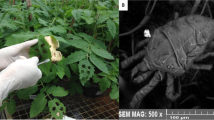Abstract
There were significant differences in the level of susceptibility among the 12 varieties which were screened for resistance to A. lycopersici Pronounced tolerance to leaf damage was recorded on varieties Early Stone Improved and Beauty. Oxheart and Bonny Best both of which had comparatively lower mite densities were highly susceptible. Flower bud formation was not significantly affected by the mite damage. However, the number of dead flowers and flower buds on infested plants was significantly more than on protected ones.
Russetting of young fruits due to mite damage differed significantly among the varieties tested, and was positively correlated with moisture content of young fruits. The least and most affected varieties were Beauty and Red Cloud respectively. The percentage yield loss was highest on Hybrid Beefmaster and Oxheart and lowest on Roma and Money Maker.
Résumé
Des différences significatives existent quant au degré de sensibilité des variétés de tomate testées pour la resistance à A. lycopersici Une tolérance remarquable aux dégâts foliaires a été observée sur les variétés “Early Stone Improved”, et “Beauty”. “Oxheart” et “Bonny” sur lesquelles on observe des densités faibles de mites sont aussi sensibles. La formation de boutons floraux n’est pas affectée de façon significative par les dégâts dus aux mites. Cependant, le nombre de fleurs et de boutons floraux dessechés sur les plantes infestées est significativement plus important que sur celles protegées. Le bruinissement des jeunes fruits dû aux dégâts des mites est significativement différent entre les variétés testées; et il existe une corrélation positive avec le taux d’humidité des jeunes fruits. Les variétés les plus et moins affectées sont “Beauty” et “Red Cloud” respectivement. Le pourcentage de perte en rendement est le plus élevé sur l’hybride “Beef Master” et “Oxheart” alors qu’il est le plus bas sur “Roma” et “Money Maker”.
Similar content being viewed by others
References
Anonymous (1975) Annual Report, Ministry of Agriculture, Central Province, Kenya, p. 41.
Anonymous (1976) Annual Report, Ministry of Agriculture, Central Province, Kenya, p. 25.
Anonymous (1984) Horticultural Crops. Development Authority Export Statistics of figures of fresh fruits, vegetables and cut flowers by air from Kenya to various destinations.
Consenza G. W. and Green H. B. (1979) Behaviour of the tomato fruitworm, Heliothis zea (Boddie) on susceptible and resistant lines of processing tomatoes. Hon. Science 14, 171–173.
Emden H. F. van (1966) Plant insect relationships and pest control. World Rev. Pest. Cont. 5, 115–123.
Gentile A. G., Webb E. R. and Stoner A. K. (1969) Lycopersicon and Solanum spp. resistant to the carmine and the two spotted spider mite. Econ. Entomol. 61, 835–836.
Gilbert J. C., Chinn J. T. and Tanka J. (1966) Spider mite tolerance in multiple disease resistant commercial type tomatoes. Proc. Am. Hort. Sci. 89, 559–562.
Horber E. (1972) Plant resistance to insects. Agric. Sci. Rev. 10, 1–18.
Kamau A. W. (1977) Effect of Eriophyid mite, Aculops lycopersici (Massee) (Acarina: Eriophyidae) on tomato in Kenya. The Entomol. News No. 5, p. 4.
Maxwell F. G. (1972) Host plant resistance to insects nutritional and pest management relationships in insect and mite nutrition (Edited by Rodriguez J. G.), pp. 599–609. North-Holland Amsterdam.
Mwakha E. (1976) Tomatoes. In Hort. Handbk. Vol. 2. The Editorial Committee of the National Horticultural Research Station, Thika, Kenya.
Painter R.H. (1951) Insect Resistance in Crop Plants. The Macmillan Co., New York.
Rodriguez J. G., Knavel D. E. and Aina O. J. (1972) Studies of resistance of tomatoes to mites. J. Econ. Entomol. 65, 51–53.
Stevens A. M. (1978) Breeding tomatoes for processing. Proceedings of the First International Symposium on Tropical Tomato. 23-27 October 1978. AVRDC publication, pp. 201–213.
Author information
Authors and Affiliations
Rights and permissions
About this article
Cite this article
Kamau, A.W., Mueke, J.M. & Khaemba, B.M. Resistance of Tomato Varieties to the Tomato Russet Mite, Aculops Lycopersici (Massee) (Acarina: Eriophyidae). Int J Trop Insect Sci 13, 351–356 (1992). https://doi.org/10.1017/S1742758400013618
Received:
Revised:
Published:
Issue Date:
DOI: https://doi.org/10.1017/S1742758400013618




